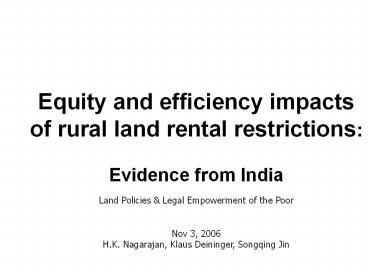Equity and efficiency impacts of rural land rental restrictions: Evidence from India - PowerPoint PPT Presentation
1 / 18
Title:
Equity and efficiency impacts of rural land rental restrictions: Evidence from India
Description:
Origin & justification of rental restrictions. Are land markets still backward & exploitative? ... Is there a justification for restrictions? Wealth bias in ... – PowerPoint PPT presentation
Number of Views:56
Avg rating:3.0/5.0
Title: Equity and efficiency impacts of rural land rental restrictions: Evidence from India
1
Equity and efficiency impacts of rural land
rental restrictions Evidence from India
Land Policies Legal Empowerment of the
Poor Nov 3, 2006 H.K. Nagarajan, Klaus
Deininger, Songqing Jin
2
Background Motivation
- Rental markets Concepts Empirical evidence
- Transfer (temporary) to better cultivators low
risk - Facilitate link to off-farm economy
consolidation of holdings - Rapid expansion with economic growth (China,
Vietnam) - But Limited extent in India why and what to do
about it? - Questions to be addressed
- Origin justification of rental restrictions
- Are land markets still backward exploitative?
- What is the equity/efficiency impact of rental
restrictions? - Methodology
- Simple household model of land market
participation - Use of state-level variation in rental
restrictions - Measure for household ability to assess
productivity impact
3
Origin nature of rental restrictions
- Land-reform related interventions
- Elimination of intermediaries
- Ownership ceilings
- Tenancy reform Rent ceilings tenancy rights
- Variations in implementation effort
- Slow implementation
- Many loopholes
- Limitations in scope
- Evidence on impact
- Nation-wide state level regressions
- West Bengal?
- Second generation problems?
4
Evidence on implementation
5
Theoretical predictions
- Rental restrictions in urban areas
- Textbook example for policy distortion
- Benefits sitting tenants reduces mobility
- Reduces investment supply of land to rental
market - Social cost will increase over time as demand
increases - Reasons for greater importance in rural areas
- Higher elasticity of supply (self or wage
cultivation) - Impact on productive efficiency Size
generational shift - Sharecropping less flexible with possibly high
investment impact - Evidence from studies in India
- Case studies High level of informality
contravention of law - Aggregate studies Positive short-term impact of
reforms - But no assessment of cost or longer-term effects
- This will be needed to guide policy
6
Model Setup
- Households endowed with endowments of labor ( )
and land ( ), and agricultural ability (?i) - Households divide labor between farm work and
off-farm wage employment - No farm labor market, renting of land incurs
transaction costs - Households maximize income by optimizing labor
allocation and choosing optimal operated land
size through rental - Policy restrictions (3 versions) affect
transaction costs
7
Conceptual framework
8
Data descriptive statistics
- Data sources
- NCAER ARIS/REDS panel data 1982 1999
- About 7,500 obs. in 2 periods
- Household characteristics
- Increased educational attainment (26 to 50)
- Narrowing of N-S gap asset inequality decreased
- Land p.c. dropped income growth of 3 p.a.
- Economic structure
- Agriculture very important (70 to 63)
- Higher participation in agr. wage employment (36
to 43) - Share of self-employment broadly constant
9
Key household characteristics by region
10
Rental Activity and Determinants
- Rental market activity
- Increase in overall activity (5 to 10 out)
- More hhs renting than benefited from reform
- Increased share of landless (12 to 37)
- Characteristics by nature of market participation
- Asset-poor rent in, rich rent out
- Gap narrowed slightly over time in panel
- High share of wage workers renting in
11
(No Transcript)
12
Determinants of market participation
- Overall equation
- Landless and poor, labor abundant likely to rent
in - Education, village income increase renting out
- Ability increase rent-in robust to inclusion
- No minimum wealth requirement input/credit
market - Lower bound (out to autarky)
- Policy variables More autarky laws lt implement.
- SC/ST increases time decreases transaction
costs - Upper bound (autarky to in)
- Implementation, but not law increases autarky
- Autarky areas decreased, i.e. markets more active
- But long time to offset impacts of restrictions
13
(No Transcript)
14
Equity efficiency impacts
- Why expect differential impacts?
- Circumventing restrictions easier for rich than
poor - Is there a trade-off between equity efficiency?
- Empirical results
- Restrictions wipe out advantage of landless in
accessing land - Once this accounted for, no more effect of
legislation - Robust to inclusion of ability
- Increases autarky band for higher ability people
15
(No Transcript)
16
Variation over time equity impact
- Is there a justification for restrictions?
- Wealth bias in 1982, no more in 1999
- No reverse tenancy, increased supply by large
owners - Monopolistic landlord behavior to extract rent?
- Potential equity impact of rental access
- Mean return/labor day close to R 150 ( VMPL)
- Compare to wage rate for ag. labor R 46 or 34
- -gt Significant welfare gains, especially for women
17
(No Transcript)
18
Conclusion and policy implications
- Land rental market functioning
- Improve equity and efficiency
- Wealth bias eliminated over time
- But impeded by tenancy legislation
- Large benefits from increased access (women)
- Policy implications
- Improve equity efficiency by reducing
restrictions - Doing so is not infeasible
- Sitting tenants welfare to be considered
- This can increase welfare significantly but is
second best to deal with problem of inequality































